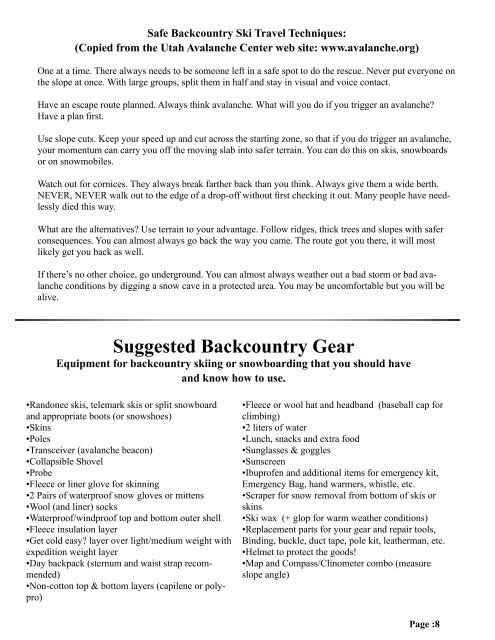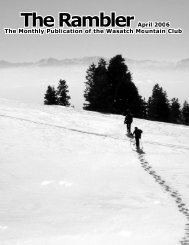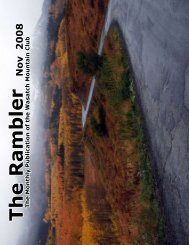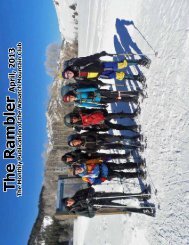The Rambler
Feb - Wasatch Mountain Club
Feb - Wasatch Mountain Club
- No tags were found...
Create successful ePaper yourself
Turn your PDF publications into a flip-book with our unique Google optimized e-Paper software.
Safe Backcountry Ski Travel Techniques:<br />
(Copied from the Utah Avalanche Center web site: www.avalanche.org)<br />
One at a time. <strong>The</strong>re always needs to be someone left in a safe spot to do the rescue. Never put everyone on<br />
the slope at once. With large groups, split them in half and stay in visual and voice contact.<br />
Have an escape route planned. Always think avalanche. What will you do if you trigger an avalanche?<br />
Have a plan first.<br />
Use slope cuts. Keep your speed up and cut across the starting zone, so that if you do trigger an avalanche,<br />
your momentum can carry you off the moving slab into safer terrain. You can do this on skis, snowboards<br />
or on snowmobiles.<br />
Watch out for cornices. <strong>The</strong>y always break farther back than you think. Always give them a wide berth.<br />
NEVER, NEVER walk out to the edge of a drop-off without first checking it out. Many people have needlessly<br />
died this way.<br />
What are the alternatives? Use terrain to your advantage. Follow ridges, thick trees and slopes with safer<br />
consequences. You can almost always go back the way you came. <strong>The</strong> route got you there, it will most<br />
likely get you back as well.<br />
If there’s no other choice, go underground. You can almost always weather out a bad storm or bad avalanche<br />
conditions by digging a snow cave in a protected area. You may be uncomfortable but you will be<br />
alive.<br />
Suggested Backcountry Gear<br />
Equipment for backcountry skiing or snowboarding that you should have<br />
and know how to use.<br />
•Randonee skis, telemark skis or split snowboard<br />
and appropriate boots (or snowshoes)<br />
•Skins<br />
•Poles<br />
•Transceiver (avalanche beacon)<br />
•Collapsible Shovel<br />
•Probe<br />
•Fleece or liner glove for skinning<br />
•2 Pairs of waterproof snow gloves or mittens<br />
•Wool (and liner) socks<br />
•Waterproof/windproof top and bottom outer shell<br />
•Fleece insulation layer<br />
•Get cold easy? layer over light/medium weight with<br />
expedition weight layer<br />
•Day backpack (sternum and waist strap recommended)<br />
•Non-cotton top & bottom layers (capilene or polypro)<br />
•Fleece or wool hat and headband (baseball cap for<br />
climbing)<br />
•2 liters of water<br />
•Lunch, snacks and extra food<br />
•Sunglasses & goggles<br />
•Sunscreen<br />
•Ibuprofen and additional items for emergency kit,<br />
Emergency Bag, hand warmers, whistle, etc.<br />
•Scraper for snow removal from bottom of skis or<br />
skins<br />
•Ski wax (+ glop for warm weather conditions)<br />
•Replacement parts for your gear and repair tools,<br />
Binding, buckle, duct tape, pole kit, leatherman, etc.<br />
•Helmet to protect the goods!<br />
•Map and Compass/Clinometer combo (measure<br />
slope angle)<br />
Page :8
















